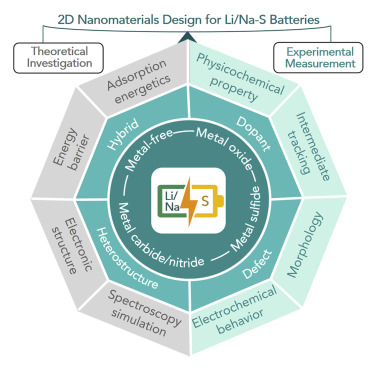Matter ( IF 18.9 ) Pub Date : 2020-02-05 , DOI: 10.1016/j.matt.2019.12.020 Chao Ye , Dongliang Chao , Jieqiong Shan , Huan Li , Kenneth Davey , Shi-Zhang Qiao

|
Metal-sulfur batteries hold practical promise for next-generation batteries because of high energy density and low cost. Development is impeded at present, however, because of unsatisfied discharge capacity and stability in long cycling. Combination of experimental and theoretical approaches can be used to develop insight into the relationship between electrochemical behavior of sulfur redox and metal stripping-plating and the structural properties of electrode materials. With metal-sulfur batteries, two-dimensional (2D) nanomaterials are a suitable model with which to connect and test experimental results with theoretical predictions and to explore structure-property relationships. Here, through the view of combining experimental and theoretical approaches, we explore sulfur redox conversion on 2D nanomaterials in various reaction stages and critically review crucial factors affecting 2D nanomaterials as artificial solid electrolyte interfaces (SEIs) and host materials in protecting Li and Na metal anodes. We conclude with a focused discussion on promising research orientations for developing high-performance metal-sulfur batteries.
中文翻译:

从理论和实验上揭示锂/钠-硫电池二维材料的研究进展
金属硫电池具有高能量密度和低成本,因此在下一代电池中具有实用的前景。但是,由于放电容量和长时间循环的稳定性不足,目前阻碍了其发展。实验方法和理论方法的结合可用于深入了解硫氧化还原和金属剥离镀的电化学行为与电极材料的结构特性之间的关系。对于金属-硫电池,二维(2D)纳米材料是一种合适的模型,通过该模型可以连接和测试具有理论预测的实验结果,并探索结构-特性关系。在这里,通过结合实验和理论方法,我们探索了二维纳米材料在不同反应阶段中的硫氧化还原转化率,并严格审查了影响二维纳米材料的关键因素,这些二维因素是人工固体电解质界面(SEI)和主体材料,用于保护锂和钠金属阳极。最后,我们重点讨论了开发高性能金属硫电池的有前途的研究方向。


























 京公网安备 11010802027423号
京公网安备 11010802027423号